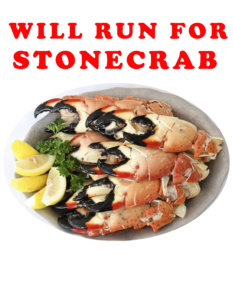Florida’s recreational and commercial stone crab season in state and federal waters will end on May 2, with the last day of harvest being May 1. Commercially harvested stone crab claws may be possessed and sold during the closed season but only if they have been placed in inventory prior to May 2 by a licensed wholesale or retail dealer.
 Stone crab traps must be removed from the water within five days after the close of the stone crab season. Stone crab claws may not be harvested from traps pulled after the season closes.
Stone crab traps must be removed from the water within five days after the close of the stone crab season. Stone crab claws may not be harvested from traps pulled after the season closes.
For more information on harvesting stone crabs for recreation, trap specifications, commercial stone crab regulations and licensing information, go online to MyFWC.com/Marine.
Keep up to date with saltwater and freshwater fishing regulations on your phone by downloading the Fish Rules app in the App Store or Google Play. Learn more at FishRulesApp.com.
Source: Stone crab season ends May 2 | FWC
The Florida stone crab (Menippe mercenaria) is a crab found in the western North Atlantic, from Connecticut to Belize, including Texas, the Gulf of Mexico, Cuba, The Bahamas, and the East Coast of the United States. The crab can also be found in and around the salt marshes of South Carolina and Georgia. It is widely caught for food. The closely related species Menippe adina (gulf stone crab) is sometimes considered a subspecies – they can interbreed, forming hybrids – and they are treated as one species for commercial fishing, with their ranges partly overlapping. The two species are believed to have diverged approximately 3 million years ago.
The Florida stone crab is usually fished near jetties, oyster reefs or other rocky areas, just as for blue crabs. The bodies of these crabs are relatively small and so are rarely eaten, but the claws (chelae), which are large and strong enough to break an oyster’s shell, are considered a delicacy. Harvesting is accomplished by removing one or both claws from the live animal and returning it to the ocean where it can regrow the lost limb(s). To be kept, claws must be 75 mm (2+7⁄8 in) long, measured from the tips of the immovable finger to the first joint.
In 1978, and in the Everglades National Park Research Center, wild caught crabs were kept in an aquarium for the specifics of testing mortality rates of declawed crabs. Mortality rates of 47 percent for doubly declawed and 28 percent for single declawed crabs were evident. In the 2011 season the mortality rates had increased to 62.9 percent and 40.8 percent respectively. In retrospect, 20 percent of landed claws are regrown.
In the United States, Florida stone crabs are legal for harvest from October 15 until May 15. The catch varies from year to year, ranging between 2.0 and 3.5 million in the period 1982–2009, overwhelmingly from the Gulf coast (as opposed to Atlantic coast). This is believed to be the maximum amount possible, given current environmental conditions, regulations, and practices. The number of traps tripled between 1989–1990 and 2009–2010 without haul increasing (hence having a very low catch-per-trap level). However, due to fisheries management, the haul is believed to be stable, as sufficient spawning happens.
Claws are sold by size, generally in four sizes: medium, large, jumbo, and colossal.
The top buyer of stone crab claws is Joe’s Stone Crab in Miami, and it plays a significant role in the industry, influencing the wholesale price and financing many crabbers. The Monterey Bay Aquarium has given the Floridian stone crab fishery its highest rating of “Best Choice” for maintaining high fishing standards and working hard to keep the stone crab a viable fishery.
These Keys Treasures Designs and many more are available on products such as T-Shirts, Stickers, Magnets, Mugs, Phone Cases, and much more at KeysTreasures.ReBubble.com




